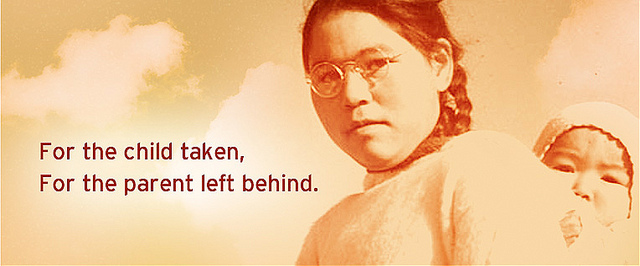Next week will mark the end of government funding to investigate the truth and impact of residential schools through the Truth and Reconciliation Commission of Canada (TRC). The TRC’s goals were to educate Canadians about this dark part of our history and support the healing of residential school survivors.
Do Canadians now understand their complicity in First Nations’ health and social challenges? Are we ready to accept that the abuse First Nations suffered at the hands of our government continues to debilitate their communities?
Patrick Etherington, Sr. and five other people from grassroots action TRC Walkers left Cree Territory, Cochrane, Ontario on April 8 and have made their way to Ottawa, on foot, for the final TRC report next week.
To bear witness to other TRC reports, members of this same group walked to Winnipeg and Halifax. This time, the Walkers made it to Toronto on Mother’s Day weekend, a sad irony for those who had been taken from their mothers as children. Then, the TRC Walkers passed through Peterborough as Canadians celebrated the birthday of colonialist Queen Victoria.
The TRC Walkers see their journey as the ceremonial counterpart to the TRC, but it’s also intended to build awareness. Etherington wants Canadians to hear what it was like for First Nations children to be taken from their families, as part of a 150-year effort to eradicate First Nations culture.
The last residential school closed in the mid-1990s, meaning, the Canadian government has committed acts of genocide in recent history, to use the words of TRC Chair, Justice Murray Sinclair.
In 2008, the Prime Minister admitted the government had made an error in trying to wipe out First Nations traditions. The TRC was created as an official container for the testimony of residential school survivors.
However, Etherington alleges that this process was short-lived and shallow given the lingering impacts that weaken First Nations communities.
The TRC ends June 3, but the problems created by residential schools loom larger than ever and this is just the beginning for reconciliation.
Parenting disrupted for 150 years
Every culture has its own traditions around nurturing families and the governance of communities. For Canada’s First Nations, these traditions were purposely disrupted for multiple generations by the federal government.
When average Canadians say they don’t understand why First Nations can’t “get it together,” consider the fact that people who were taken from their families, institutionalized and abused generally have a harder time with parenting and other forms of leadership. “Intergenerational effects” thread their way painfully through survivors’ families.
Etherington points out that the Children’s Aid Society is taking First Nations children into their care at greater rates now than at the height of the Residential School Era.
“What was done to the survivors, how they were taken away from their humanity, themselves. They were on survival mode from that time on. Something happened within the context of creating the human being, being almost like a robot in the situation, how it was done… A young child needs the mother and father, that relationship with substance, also identity, ethical values and understanding of our homeland. And that disturbance causes that child to become someone else,” says Etherington.
Etherington’s message is that the public needs to be educated and to hear survivors’ descriptions of what was lost.
“That’s how the story of the Indian Residential School has to be focused on. Not just to focus on how the government is going to create [the Truth and Reconciliation Commission]… Truth is one part but towards reconciliation is a bigger process. And it’s in a different process and that process needs to be created with more meaning to it and all the elements that come with it. One element is treaty and another is education.”
From victimhood to leadership
It was his father, Etherington says, who inspired him “to step away from the pain and the victim place.” He then felt guided to coordinate a ceremonial counterpart to the TRC as a group whose mandate wouldn’t end with the government funding. The TRC Walkers have prepared, spiritually, emotionally, mentally and physically for next week’s report. They’ll make sure the fire is lit and the teachings are shared because they feel a responsibility to support the healing of their communities.
Both Etherington and TRC Chair Sinclair suggest First Nations experiences, historically and currently, need to be part of all Canadians’ education; our understanding of Canada is incomplete until we hear from First Nations, in their own words, and acknowledge their reality today.
On-reserve First Nations continue to receive less money per capita for basic services than the rest of Canada, keeping them trapped in poverty. The disappearance of hundreds of First Nations women is not unrelated to the history of abuse that began in residential schools.
Taken together, these issues represent a national crisis, acknowledged even within the UN. The response must begin with listening to the solutions that are being proposed by the survivors themselves.
The TRC Walkers are collecting donations on the GoFundMe to support the logistics of their walk. This means the helpers. Etherington explains that when beginning a ceremony, they always call in the helpers. On this walk, they are being the helpers, supporting healing for residential school survivors.
Natalie Robinson is a community organizer in rural Ontario. She has a weekly column in the Pembroke Daily Observer called “Your Mama’s Economics” and, in the past, she was a guest blogger for Corporate Knights. Natalie recently co-founded Homespin, an organization devoted to DIY economic development and collaborative marketing for small business. Prior to that she designed the Sustainability Education program for Algonquin College while completing an MA in Environmental Education and Communication.
Photo: flickr/ Neeta Lind



